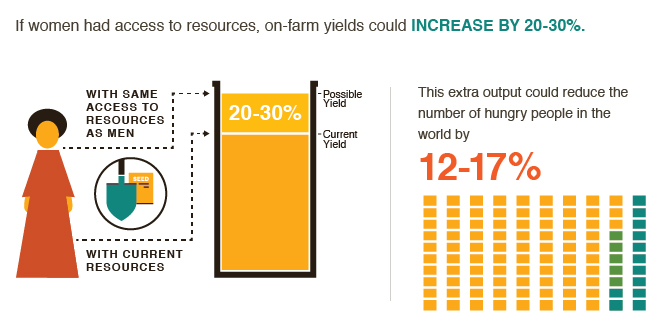Gender

Facts
- Women tend to be more at risk from climate change than are men because they represent the majority of the world’s poor. This means they often lack the means to cope with the harmful effects of climate change. Women also tend to be more dependent on livelihoods and natural resources that are more sensitive to climatic changes than are men (UNDP, GGCA 2012 pp. 2–3).
- Women appear more vulnerable than men to the effects of natural disasters, with the impacts strongly linked to poverty. A few studies following the cyclone and flood disasters of 1991 in Bangladesh revealed that the death rate was 71 per 1000 among women aged 20–44, compared with 15 per 1000 for men of similar ages (WEDO 2008 p. 51).
- More and more agricultural work is being done by women as men move to non-farm jobs. In all parts of the world except Europe, the proportion of women in the total agricultural work force has risen over the past four decades (Doss 2011 p. 6).
- Women often have responsibilities, such as fetching water, collecting fuelwood, and looking after children that make them more vulnerable than men to the impacts of climate change (Wright and Chandani 2014).
- For example, in many developing countries women are the primary collectors, users and managers of water, so drought and water shortage can increased their workload (UNDP 2010).
- Female farmers produce less than their male counterparts because they have less access to or ownership of land, use fewer inputs and have less access to important services such as extension services. In many countries women are only half as likely as men to use fertilizers (FAO 2011 pp. 38, 45).
- If women had the same access to productive resources as men, they could increase yields on their farms by 20–30%. This could raise total agricultural output in developing countries by 2.5–4%, which could in turn reduce the number of hungry people in the world by 12–17% (FAO 2011 p. 5).
- Men have greater access to information than women. For example, in Kyengeza, Uganda, 80% of the men listen to the radio for daily weather forecasts, compared with only 20% of women (Kyazze et al. 2012 p. 12).
Sources and further reading
- Doss C. 2011. If women hold up half the sky, how much of the world’s food do they produce? ESA Working Paper No. 11–04. Rome: Agricultural Development Economic Divison Food and Agricultural Organisation of the United Nations. (Available from http://www.fao.org/docrep/013/am309e/am309e00.pdf)
- [FAO] Food and Agriculture Organization of the United Nations. 2011. The state of food and agriculture 2010–2011. Women in agriculture: Closing the gender gap for development. Rome: FAO. (Available from http://www.fao.org/docrep/013/i2050e/i2050e.pdf)
- Kyazze FB, Owoyesigire B, Kristjanson P, Chaudhury M. 2012. Using a gender lens to explore farmers’ adaptation options in the face of a changing climate: Results of a pilot study in Uganda. CCAFS Working Paper No. 26. Copenhagen: CGIAR Research Program on Climate Change, Agriculture and Food Security. (Available from http://cgspace.cgiar.org/handle/10568/23017)
- [UNDP] United Nations Development Programme. 2010. Gender, climate change and community-based adaptation. A guidebook for designing and implementing gender-sensitive community-based adaptation programmes and projects. New York, USA: UNDP. (Available from http://www.gender-climate.org/Content/Docs/Publications/A35_undp_Gender_Climate_Change_and_Community_Based_Adaptation.pdf)
- [UNDP, GGCA] United Nations Development Programme, Global Gender Climate Alliance. 2012. Overview of linkages between gender and climate change. Policy Brief. (Available from http://www.gender-climate.org/Content/Docs/Publications/UNDP_Policy-Brief-Overview-of-linkages-between-gender-and-climate-change.pdf) (Accessed 4 November 2013)
- [WEDO] Women’s Environment & Development Organization. 2008. Gender, climate change, and human security: lessons from Bangladesh, Ghana and Senegal. New York, USA: WEDO. (Available from http://www.wedo.org/themes/sustainable-development-themes/climatechange/gender-climate-change-human-security) (Accessed 4 November 2013)